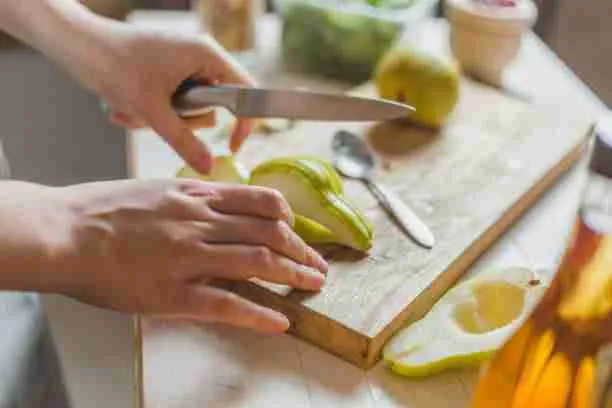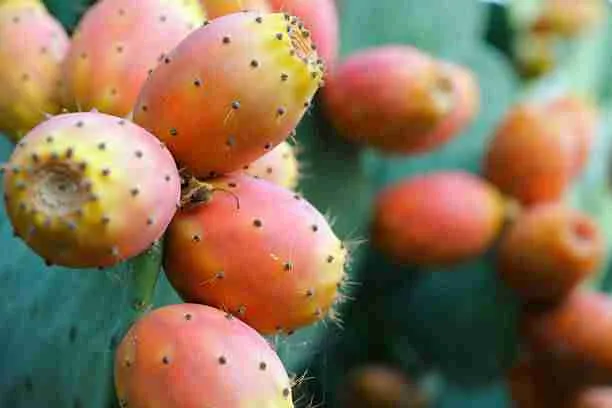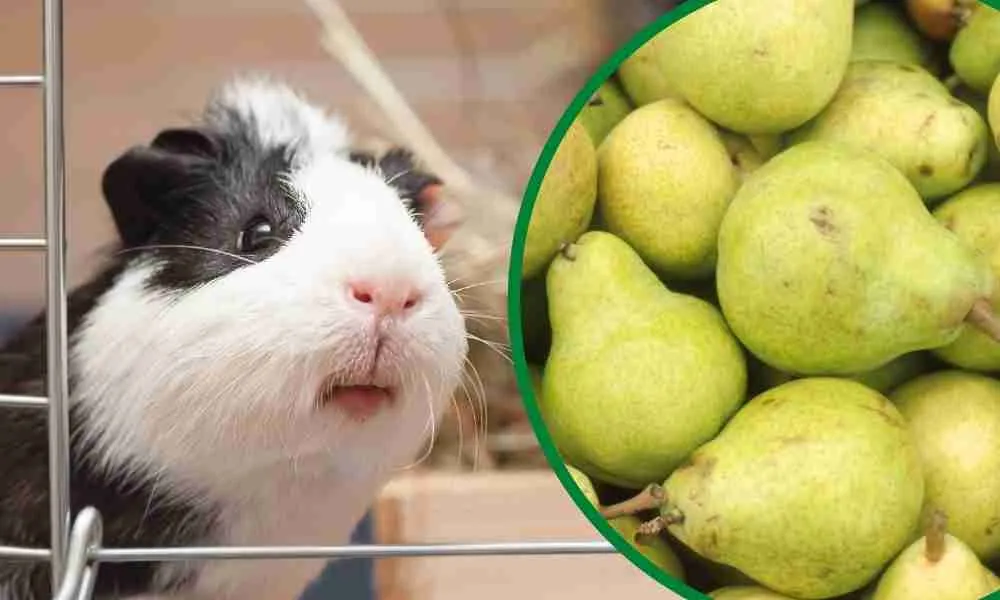Pear is one that’s loved by many people around the world. Interestingly, they’re mostly enjoyed raw and you feel they’ll be okay for your cavy too.
As a guinea pig owner, you always try to be sure about what you feed them and this makes you wonder, can guinea pigs eat pears?
Yes! Guinea pigs can eat pears. It has vitamin C and your cavy needs it to be in good condition and stay immune to several diseases. However, they can only eat it as treats and a maximum of two days a week – nothing more!
Unlike humans, guinea pigs can only have a small amount.
This has nothing to do with their ability to eat pear but an important serving size that allows them to eat it without trouble. Their main diet is mostly hay, so pear, like other fruits and veggies, are just smaller parts of it.
However, that’s not all about pears!
You should also know that pear has different parts. Probably, you’re not sure if all parts are safe for them to eat.
Moreover, this concern makes you wonder, can guinea pigs eat the whole pear?
Let’s dive deeper into this article to know more about this.
Table of Contents
Can Guinea Pigs Eat The Whole Pear?
No! They can’t eat a whole pear. Not all parts can be given to them to eat. There are parts of pear that are fine to feed and some that should be left out.
Let’s look at some of these parts and know if they’re okay to serve your furry friend.
Can Guinea Pigs Eat Pear Leaves?
Yes, they can. It’s okay to feed your cavy pear leaves.
Once in a while, you can chop it and serve a few pieces to them. Just like apple, banana, and grape leaves, pear leaves are among the safe leaves to feed your guinea pigs.
Can Guinea Pigs Eat Pear Cores?
No! They can’t eat this part. These pear cores hold toxic pear seeds that aren’t good for your furry friend.
Moreover, humans avoid this part, so your delicate pet shouldn’t be allowed to eat it either. Always make sure you cut off this part anytime you plan to serve pear to your guinea pig.
Can Guinea Pigs Eat Pear Seeds?
Not at all! These seeds aren’t safe for your pet to eat. Their sharp sides can harm soft areas in your cavy’s mouth and also injure their throat.
Also, these pear seeds are known to have little cyanide in them.
This might be a small amount to harm your little pet but you should avoid these seeds to keep things safe.
How Often Can Guinea Pigs Have Pears?
You should only let your cavy have pears for just a day or two in one week. Pear, just like other sweet fruits, is acidic with too much sugar and cannot be a daily meal for guinea pigs.
It’s better served as a treat which they’ll have on rare occasions.
This way, they get to eat pear without trouble as too much of it can make them sick. Also, if you plan to serve them pear twice, it should be at least 2-3 days apart.
However, since your guinea pig can only eat pears as treats and just for a few days, are they safe for baby guinea pigs?
Let’s find out next!
Can Baby Guinea Pigs Eat Pears?
No, you shouldn’t feed pear to baby guinea pigs. They are too delicate at such an age to have such a sweet fruit like a pear. The sugar in it is high and that’s not okay for them as babies.
Generally, fruits don’t normally come into the diet of baby guinea pigs.
At this stage, they need their mother’s milk the most. As time goes on, hay, pellet, and most guinea pig foods will come in before fruits and veggies do.
When they’re about 5 weeks of age, they will be able to digest fruits, especially sweet ones like pears, without facing any health issues.
As we go further, we’ll be looking at the nutritional value of a pear per 100 g serving size.
Nutritional Value of Pears
| Nutrients | Per 100 g |
| Fiber | 3.1 g |
| Vitamin C | 6 mg |
| Calcium | 9 mg |
| Protein | 0.36 g |
| Carbohydrates | 15.23 g |
| Vitamin A | 25 IU |
| Phosphorus | 12 mg |
| Vitamin K | 4.4 ug |
| Potassium | 116 mg |
| Sugar | 9.75 g |
| Calories | 57 Kcal |
| Fats | 0.14 g |
| Water | 83.96 g |
Health Benefits of Pears for Guinea Pigs
Pear isn’t just a tasty fruit your cavy can enjoy but also one that’s very healthy for them. Let’s look at some of these health benefits of pear for your cavy.
- Supports the Immune System
Pear contains many antioxidants, especially vitamin C that’s very important for your guinea pigs to stay healthy.
Since guinea pigs’ bodies can’t create the vitamin C it needs, they can always get it from vitamin C enriched fruits like pears.
Vitamin C will help prevent scurvy. Also, with other antioxidants like copper in pear, their immunity will be strengthened against other diseases that may arise.
- Aids Digestion
Pear, especially the skin, has lots of dietary fiber in it. You’ll find two types – soluble and insoluble fiber. They both help your guinea pig in digesting other foods easily and also soften the stools of your cavy.
- Improves Cardiovascular Well being
Potassium is in pear and this nutrient helps the muscles contract well, especially that of the heart. This helps the heart to function well.
Certain compounds in pear also help prevent the rise of any heart disease and maintain all-around heart health.
- Aids Weight Loss
It’s interesting to know that pear has few calories in it. On the other hand, they contain lots of fiber and water.
This can fill your guinea pig easily thereby reducing the amount of food they’ll need to eat at once to get filled. This way, they can eat less
How to Prepare Pears for Guinea Pig

Having said much about the high sugar content in pear and how important we have to keep things moderate, there’s a great need to prepare them well.
A wrong preparation will create risks for their health.
Here are a few steps to guide you as you make this treat for your little pet.
Step 1: Use Only Fresh Pears
When choosing the pear to prepare, make sure it’s fresh. Moreover, you should not use overripe pear and one with odor.
If you have ones at home that grew naturally, that’s a better option as most ones in stores may have harmful chemicals on them.
Step 2: Remove Pear Seeds and Core
You should only use the skin and flesh of pears while making this treat. The seeds and core aren’t fine for guinea pigs to eat.
So, you should take note of these parts and remove them while preparing pear treats.
Step 3: Wash Pear Thoroughly
Hygiene is important when caring for a pet as delicate as a guinea pig, especially in their diet. So, this isn’t a part to neglect at all.
After removing the seed, rinse the pear, preferably in running water, to get rid of any harmful chemicals, dirt, or germs on them.
Most importantly, as we will be using the pear skin, we have to make sure it is clean and safe enough for your cavy to eat.
Step 4: Slice Pear into Moderate Pieces
This is the part that can create risks for your guinea pig’s health if you do it wrong. You can’t serve a full pear to your guinea pig. Instead cut the pear into very thin slices with the skin on them.
This size helps reduce the amount of sugar and other components that are bad for your guinea pig in excess. The skin holds important nutrients for them that the flesh itself doesn’t have at all.
So, you’ll be keeping things balanced and also making a healthier treat this way.
Step 5: Serve Already Prepared Pear
Serve about a thin slice of pear in a clean bowl and not on the bare floor. It’s ideal to serve pear without any other sweet fruits as that would be too much sweet stuff for your cavy.
The sugar in the pear is already too much so you don’t want to add more to it, especially after keeping it moderate.
Take Note!
Guinea pigs can react when they try out new foods. So, it’s best if you gradually introduce pears to them. First serve your cavy a smaller amount of pear, like a quarter or half of the normal serving size, and check for any reactions.
If you notice any negative reactions, try reducing them more and only increase them again if they get used to it.
However, if your cavy seems to have no problem with a smaller size, give them the normal serving size and if the case is the same, you can always increase it.
Also, once your cavies are done eating their pear treat, you should always tidy up the area, especially removing pear leftovers. These leftovers normally get exposed to flies and bacteria, especially when it stays too long.This is not what you want to get into your guinea pigs’ mouths as it can harm their health badly.
What Type of Pears Can Guinea Pigs Eat?
Let’s look at some types of pear and also how safe they are to feed your guinea pig.
Can Guinea Pigs Eat Prickly or Cactus Pears?

Yes, your guinea pig can eat prickly pears. However, you should peel off the skin and the thorns on them whenever you’re preparing them for your furry friends. So, serve only the flesh.
Nevertheless, you’ll find useful nutrients like fiber in it which your cavy needs a lot. Some of the benefits this pear has for your cavy are checking cholesterol and blood sugar levels in the body.
Can Guinea Pigs Eat Asian Pears?
Yes, your cavy can. Around the world, you can see them with other names like:
- Korean pear
- Japanese pear
- Nashi pear
- Apple pear,
- and even sand pear.
However, you should only serve this type of pear raw to your guinea pigs. Interestingly, its acidic content is low.
However, it’s high in sugar so it is only safe for your guinea pig to eat just once a week. In addition, the vitamin C content in it is low so it might not be one of the best types of pear to serve your cavy.
Can Guinea Pigs Eat Green Pears?
Yes, you can feed your guinea pigs green pears. The green pears are well known as D’ Anjou pears and it’s a juicy type with lots of fiber in them.
They also contain compounds that help boost vision and this would help your guinea pig as they grow older.
Can Guinea Pigs Eat Red Pears?
Yes! This type of pear is also fine for your guinea pigs to eat. Red pear is the red variety of the regular green Anjou pear. Their nutritional value isn’t quite the same as that of green pears.
These red types have more of the nutrients, such as anthocyanin, that’ll support your cavy’s blood vessels and keep their heart working in good conditions.
Pear Alternatives
In case you need other options of healthy fruits besides pear, we’ve provided you with some of them which you can add to your cavy diet below:
| Apples | Cranberries | Mangoes | Plums | Blueberries |
| Kiwi fruits | Bananas | Melons (All types) | Peaches | Grapes |
| Papayas | Orange | Apricots | Nectarines | Pineapples |
| Pears | Tomatoes | Blackberries | Raspberries | Cucumbers |
Final Thoughts
In summary, guinea pigs can eat pears. However, with the high amount of sugar and water in it, they need to eat it in bits. Also, do not go on serving them for more than two days.
Follow the steps we shared in this article while preparing these treats to avoid creating health issues for your cavy. Moreover, if you have a garden with a pear tree, that’s great. They’re safer to use.
Also, feel free to give them some pear branches. It’s good if your cavy chews them as they’ll help improve their dental health.
Hopefully, you learned a lot about pear treats by reading this article. So, don’t hesitate to share it!
